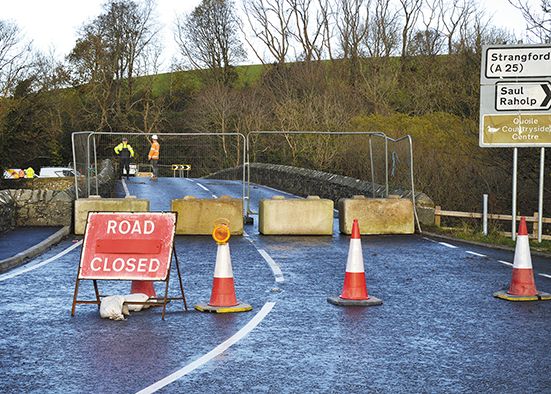Bridge too far at Quoile river
Bridge too far at Quoile river
15 November 2023

QUESTIONS are being asked about the maintenance of the Quoile river after the 100 year-old Bridge, which spans it linking the Old Belfast and Killyleagh roads, was closed on Monday due to safety concerns.
A large crack has opened between the bridge wall and the road while one of the structure’s buttresses has collapsed.
Structural engineers are carrying out a detailed investigation of the bridge and heavy concrete bollards have been placed either side of it to keep traffic away.
It’s anticipated that the bridge could be closed for some considerable time.
Politicians are calling for the outcome of the structural report to be made public, while traders say the closure of one of the main arteries into the heart of the town is another major blow on the back of the devastating flood which engulfed the town centre almost two weeks ago.
The Department for Infrastructure (DfI) says it was made aware of the defect on Monday morning and that engineers are assessing the situation.
It was initially suggested that the bridge had been damaged by severe flooding, but the DfI now believes a vehicle, possibly a lorry, was responsible.
In a social media post, the Department said the Old Belfast Road will remain closed until the assessment of the bridge is complete.
“Initial examination suggest a masonry parapet has been damaged by a vehicle,” it said.
The bridge closure has led to major traffic disruption and Monday’s closure was compounded by the closure of the nearby Finnebrogue Road due to flooding.
On Monday evening, contractors were removing grass blocking the flow of water under the bridge archways, with the DfI confirming that this work will continue as floodwaters recede.
Residents have expressed concern about the blockage of tunnels under the bridge and pointed toa similar situation at the Belfast Road bridge, in tandem with high silt levels below the waterline. They believe these factors played a major role in the recent town centre flooding.
While the cause of the major crack has not yet been officially confirmed, one theory gathering momentum was that pressure caused by a build-up of debris and toxic sludge held high water levels back which had some structural impact on the bridge at low level, causing the top part at the wall to move away from the road surface.
South Down MP Chris Hazzard said the bridge closure was yet another warning that urgent action is required to improve the free flow of rising water in the Quoile.
“Given the devastating events of a fortnight ago in Downpatrick this is extremely worrying,” he said.
“It is also clear from walking the Quoile that some areas along the river where water used to gather in deep pools, have become full with silt and debris.
“Not only does this limit the amount of increased water the Quoile basin can contain, but it also creates mats of vegetation that often break away in strong currents and are subsequently caught downstream in archways that should be kept free flowing at all times.”
Mr Hazzard said he has again urged the Department for Infrastructure to urgently assess the current situation at the Quoile and take any and all action to ensure the river is free flowing.”


